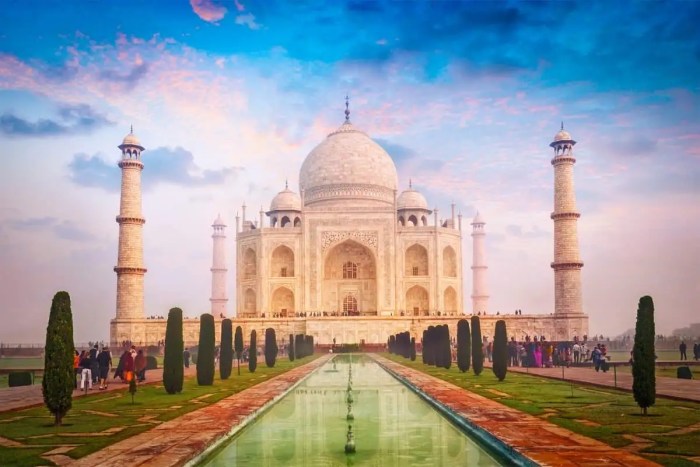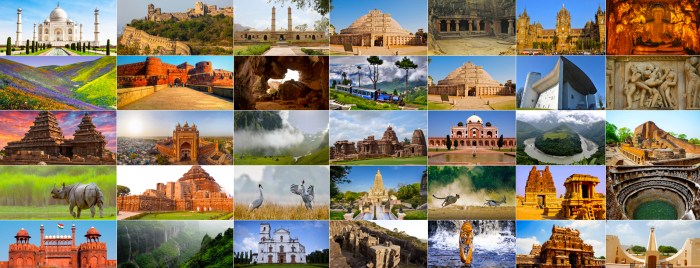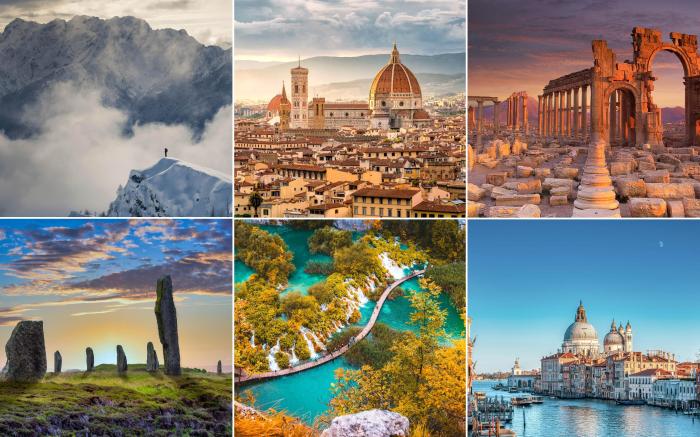UNESCO World Heritage Sites are extraordinary places of cultural and natural significance, recognized for their outstanding universal value. From the iconic Taj Mahal to the breathtaking Great Barrier Reef, these sites embody the richness and diversity of our shared human heritage. Preserving and protecting these treasures is crucial for future generations, as they hold the keys to understanding our past, present, and future.
UNESCO’s World Heritage Convention, established in 1972, provides a framework for international cooperation in safeguarding cultural and natural heritage. The Convention has designated over 1,100 sites in more than 160 countries as World Heritage Sites, ensuring their protection and preservation for all time.
Cultural Significance of UNESCO World Heritage Sites

Preserving cultural heritage is paramount for understanding and appreciating the diverse tapestry of human civilization. UNESCO World Heritage Sites play a crucial role in safeguarding and recognizing the exceptional cultural value of landmarks that transcend national boundaries and hold universal significance.
From the ancient ruins of Petra in Jordan, a testament to the ingenuity of the Nabataeans, to the vibrant colors and intricate architecture of the Great Barrier Reef in Australia, UNESCO World Heritage Sites showcase the boundless creativity and cultural achievements of humanity. These sites serve as living reminders of our shared past and inspire future generations to value and protect our cultural legacy.
The Role of UNESCO
UNESCO, the United Nations Educational, Scientific and Cultural Organization, is the leading international body responsible for identifying, protecting, and promoting cultural heritage around the world. Through its World Heritage Convention, UNESCO establishes criteria for the selection of sites based on their outstanding universal value and cultural significance.
If you’re looking for an unforgettable hiking experience, consider exploring one of the many UNESCO World Heritage Sites located in the United States. These sites offer a unique opportunity to immerse yourself in nature and history, while also getting some exercise.
From the towering peaks of the Grand Canyon to the lush rainforests of Hawaii, there’s a best hiking trails in the US for everyone. And after your hike, you can relax and enjoy the many other attractions that these UNESCO World Heritage Sites have to offer, such as museums, historical landmarks, and cultural events.
UNESCO provides technical assistance, financial support, and advocacy to ensure the preservation and management of World Heritage Sites. By recognizing and protecting these landmarks, UNESCO helps to foster cultural diversity, promote dialogue and understanding among different cultures, and inspire future generations to appreciate and safeguard our shared heritage.
Natural Wonders and Heritage Sites

Natural heritage sites encompass awe-inspiring landscapes, diverse ecosystems, and exceptional geological formations that hold immense scientific, cultural, and aesthetic value. The designation of natural sites as World Heritage Sites requires them to meet specific criteria established by UNESCO. These criteria include:
- Outstanding universal value in terms of natural beauty, geological or geomorphic formations, or habitats of endangered species.
- Superlative natural phenomena or areas of exceptional natural beauty and aesthetic importance.
- Unique or rare geological or physiographical formations or natural features, or areas containing important and significant natural habitats for in situ conservation of biological diversity.
Examples of stunning natural heritage sites include:
- Grand Canyon National Park (USA): A vast and awe-inspiring canyon carved by the Colorado River over millions of years, showcasing a diverse array of geological formations and unparalleled scenic beauty.
- Great Barrier Reef (Australia): The largest coral reef system in the world, renowned for its extraordinary biodiversity, including over 1,500 species of fish and 400 species of coral.
- Yosemite National Park (USA): Home to towering granite cliffs, cascading waterfalls, and giant sequoia trees, Yosemite Valley is considered one of the most beautiful and iconic natural landscapes on Earth.
The protection and conservation of biodiversity within these natural heritage sites are of paramount importance. They serve as refuges for endangered species, provide critical habitats for a wide range of flora and fauna, and contribute to the overall health and resilience of ecosystems. Preserving these sites ensures the continued existence of our planet’s rich and diverse natural heritage for generations to come.
Historical Heritage and Preservation

Recognizing the significance of preserving historical heritage for future generations, UNESCO established a rigorous process for identifying and evaluating historical sites for inclusion on its World Heritage List. These sites represent exceptional cultural and historical value, embodying the legacy of past civilizations and serving as invaluable sources of knowledge and inspiration.
Identification and Evaluation of Historical Sites
The process of identifying and evaluating historical sites for UNESCO recognition involves several key steps:
- Nomination: States Parties to the World Heritage Convention submit nominations for potential sites to the UNESCO World Heritage Centre.
- Technical Evaluation: The nominations are assessed by the International Council on Monuments and Sites (ICOMOS) and the International Union for Conservation of Nature (IUCN), which provide expert evaluations on the cultural and natural significance of the sites.
- Examination by the World Heritage Committee: The World Heritage Committee, composed of representatives from various countries, reviews the nominations and makes final decisions on whether to inscribe sites on the World Heritage List.
Examples of Historical World Heritage Sites
The World Heritage List includes numerous historical sites that represent significant events or periods in human history:
- Taj Mahal, India: A breathtaking mausoleum built by Mughal emperor Shah Jahan in memory of his wife, Mumtaz Mahal.
- Great Wall of China: An ancient fortification system built over centuries to protect China from invaders.
- Colosseum, Italy: An iconic Roman amphitheater that hosted gladiatorial contests and public spectacles.
Challenges and Methods of Preservation
Preserving historical heritage poses significant challenges, including:
- Natural Disasters: Earthquakes, floods, and other natural disasters can damage or destroy historical sites.
- Human Impact: Vandalism, looting, and improper restoration can also threaten the integrity of historical sites.
- Climate Change: Rising sea levels and extreme weather events can pose risks to coastal and low-lying historical sites.
Preservation methods include:
- Restoration and Conservation: Repairing and maintaining historical structures to preserve their original appearance and integrity.
- Protective Measures: Implementing measures to protect sites from natural disasters and human threats, such as security systems and flood barriers.
- Documentation and Education: Recording and sharing information about historical sites to raise awareness and promote their preservation.
Impact of Tourism on World Heritage Sites: UNESCO World Heritage Sites
Tourism has a profound impact on UNESCO World Heritage Sites, influencing their preservation, accessibility, and overall well-being. While it can generate economic benefits and raise awareness, it also poses challenges related to conservation, sustainability, and the preservation of cultural heritage.
Understanding the dual nature of tourism’s impact is crucial for developing strategies that promote responsible travel and mitigate negative effects.
Positive Effects of Tourism, UNESCO World Heritage Sites
- Economic Benefits: Tourism can generate revenue for local communities, supporting businesses, infrastructure, and employment opportunities.
- Increased Awareness: Tourism can raise awareness about the significance of World Heritage Sites, fostering appreciation and understanding of different cultures and ecosystems.
- Conservation Funding: Tourism revenue can be directed towards conservation efforts, supporting site maintenance, restoration projects, and research.
Negative Effects of Tourism
- Environmental Degradation: Mass tourism can lead to pollution, habitat destruction, and damage to fragile ecosystems.
- Cultural Erosion: Uncontrolled tourism can disrupt traditional practices, displace local communities, and erode cultural authenticity.
- Overcrowding and Congestion: Excessive tourist numbers can strain infrastructure, leading to overcrowding, congestion, and diminished visitor experiences.
Strategies for Sustainable Tourism
To minimize the negative impacts of tourism and promote responsible travel, various strategies can be implemented:
- Tourism Management Plans: Developing comprehensive plans that regulate visitor numbers, control development, and establish guidelines for sustainable practices.
- Education and Awareness: Educating tourists about the importance of responsible behavior and providing information on sustainable travel options.
- Local Involvement: Engaging local communities in tourism planning and management, ensuring that their interests and cultural values are respected.
Case Studies of Successful Tourism Management Practices
Several World Heritage Sites have successfully implemented sustainable tourism practices:
- Machu Picchu, Peru: Visitor numbers are regulated, and a permit system is in place to control access to the site.
- Great Barrier Reef, Australia: Zoning and educational programs have been implemented to protect the reef’s delicate ecosystem.
- Angkor Wat, Cambodia: Community-based tourism initiatives have empowered local communities and preserved the site’s cultural integrity.
Global Collaboration and Partnerships
International cooperation is crucial for the protection of World Heritage Sites. UNESCO collaborates with various organizations to ensure the preservation and conservation of these sites. These partnerships involve knowledge sharing, resource pooling, and capacity building.
UNESCO and the International Council on Monuments and Sites (ICOMOS)
UNESCO and ICOMOS have a long-standing partnership focused on promoting the conservation of cultural heritage. ICOMOS provides technical expertise and guidance to UNESCO on the identification, protection, and management of World Heritage Sites.
UNESCO and the World Monuments Fund (WMF)
UNESCO collaborates with WMF to safeguard cultural heritage in danger. WMF provides financial support, technical assistance, and advocacy for the preservation of World Heritage Sites threatened by natural disasters, conflicts, or neglect.
UNESCO and the World Bank
UNESCO and the World Bank work together to integrate cultural heritage preservation into development projects. The World Bank provides financial assistance for projects that protect World Heritage Sites while promoting sustainable economic development.
Education and Awareness
Education plays a pivotal role in fostering awareness and appreciation of UNESCO World Heritage Sites. Through formal and informal learning experiences, individuals can gain a deeper understanding of the cultural and natural treasures that shape our collective heritage.
Educational Programs and Initiatives
Numerous educational programs and initiatives are dedicated to promoting understanding and appreciation of UNESCO World Heritage Sites. These include:
- UNESCO World Heritage Education Program: Provides resources and training to educators worldwide to integrate World Heritage concepts into curricula.
- World Heritage Schools Program: Partners with schools to promote heritage conservation and sustainable development.
- Young Heritage Champions Program: Empowers youth to become advocates for heritage preservation.
Engaging Local Communities
Engaging local communities in heritage preservation efforts is crucial. Local communities hold valuable knowledge and traditions that contribute to the authenticity and integrity of World Heritage Sites. By involving them in decision-making processes and providing opportunities for cultural expression, communities can become active stewards of their heritage.
Threats to World Heritage Sites

UNESCO World Heritage Sites face numerous threats that can damage or destroy their cultural and natural values. These threats include climate change, pollution, development, and tourism.
UNESCO World Heritage Sites preserve cultural and natural treasures, offering a glimpse into the world’s rich heritage. Beyond these sites, immerse yourself in the vibrant traditions and celebrations of the world’s best cultural festivals worldwide. From the vibrant Holi festival in India to the lively Rio Carnival in Brazil, these events showcase the diverse cultural expressions that make our world so fascinating.
As we delve deeper into the UNESCO World Heritage Sites, let us not forget the importance of preserving and celebrating our intangible cultural heritage through these vibrant festivals.
Climate change is a major threat to World Heritage Sites, as it can cause changes in temperature, precipitation, and sea level. These changes can damage or destroy buildings, monuments, and other cultural heritage sites. Climate change can also cause natural disasters, such as floods, droughts, and wildfires, which can further damage World Heritage Sites.
Pollution is another major threat to World Heritage Sites. Air pollution can damage buildings and monuments, while water pollution can contaminate rivers, lakes, and other water bodies. Pollution can also harm wildlife and plant life, which can impact the overall ecosystem of a World Heritage Site.
When visiting UNESCO World Heritage Sites, it’s important to practice responsible tourism to preserve these invaluable cultural and natural treasures. By adopting eco-friendly travel tips , such as reducing plastic waste, choosing sustainable transportation, and supporting local communities, we can ensure that these sites remain pristine for generations to come.
This not only enhances our own travel experiences but also contributes to the preservation of our shared global heritage.
Development is a threat to World Heritage Sites when it is not done in a sustainable way. Unsustainable development can damage or destroy buildings, monuments, and other cultural heritage sites. It can also lead to deforestation, which can impact the overall ecosystem of a World Heritage Site.
Strategies and Measures to Mitigate Threats
There are a number of strategies and measures that can be implemented to mitigate the threats to World Heritage Sites. These include:
- Developing and implementing conservation plans
- Raising awareness of the threats to World Heritage Sites
- Providing financial and technical assistance to countries to help them protect their World Heritage Sites
- Working with local communities to develop sustainable development plans
- Monitoring the condition of World Heritage Sites and taking action to address any threats
Case Studies of Successful Restoration and Conservation Projects
There are a number of successful restoration and conservation projects that have been implemented to protect World Heritage Sites. These include:
- The restoration of the Great Wall of China
- The conservation of the Taj Mahal in India
- The restoration of the ancient city of Petra in Jordan
These projects have helped to preserve these World Heritage Sites for future generations.
Ultimate Conclusion

UNESCO World Heritage Sites are a testament to the creativity, ingenuity, and resilience of humanity. They are places of beauty, inspiration, and learning, and they remind us of our shared responsibility to protect and preserve our planet’s cultural and natural heritage for generations to come.
Questions Often Asked
What is the difference between a World Heritage Site and a national park?
World Heritage Sites are designated by UNESCO for their outstanding universal value, while national parks are typically designated by individual countries for their natural or cultural significance.
How are World Heritage Sites selected?
Sites are nominated by individual countries and then evaluated by UNESCO’s World Heritage Committee, which makes the final decision on whether to inscribe the site on the World Heritage List.
What are the threats to World Heritage Sites?
World Heritage Sites face a variety of threats, including climate change, pollution, development, and tourism.